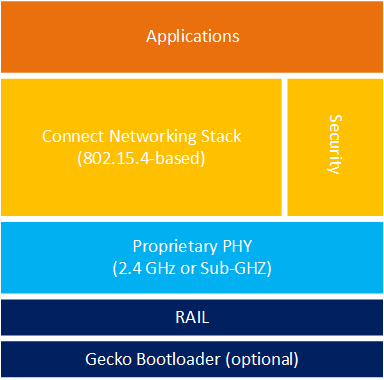Developing Proprietary Connect Applications#
Silicon Labs Connect is an IEEE 802.15.4 MAC-based wireless networking stack for a variety of proprietary applications optimized for low-power devices. This full-featured, easily customizable networking stack is designed for compliance with regulatory specifications across worldwide geographic regions and supports both Sub-GHz and 2.4 GHz frequency bands.
The Silicon Labs Connect stack supports many combinations of radio modulation, frequency and data rates. The stack provides support for end nodes, coordinators, and range extenders. It includes all wireless MAC (Medium Access Control) layer functions such as scanning and joining, setting up a point-to-point or star network, and managing device types such as sleepy end devices, routers, and coordinators. With all this functionality already implemented in the stack, users can focus on their end application development and not worry about the lower-level radio and network details.


The Connect stack is part of the Silicon Labs Flex SDK (Software Development Kit), installed through Simplicity Studio. Connect runs on top of RAIL (Radio Abstraction Interface Layer), also included with the Flex SDK. RAIL provides an intuitive, easily-customizable radio interface layer that is designed to support proprietary or standards-based wireless protocols.
The content on these pages is intended for those who want to experiment with or are already developing an application using the Silicon Labs Connect Stack.
For details about this release: Links to the Flex SDK release notes are available on the silabs.com Gecko SDK page.
For Silicon Labs' Connect product information: See the product pages on silabs.com.
For background about the Connect stack and other wireless networking topics: The Fundamentals section is a good place to start.
To get started with development: See the Getting Started section to get started working with example applications.
If you are already in development: See the Developer's Guide for details or go directly to the API Reference.
